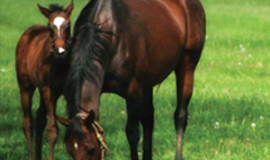Potassium (K) is the mineral (ion) found in highest concentration in all cells in the bodies of humans and animals, as well as in the cells of plants. In blood and in the fluid surrounding cells, sodium (Na) dominates, and the concentration of potassium is low. Potassium and sodium are both positive ions, and in a complicated cooperation, the two cations ensure that nerves and muscles function normally. Potassium from feed is rapidly absorbed through the gut wall and transported by the blood stream to the cells. About 75% of…
Pegus News
Adjusting rations for mares in late pregnancy
Adjusting rations for the mares in late pregnancy At this time of year, many pregnant mares are in their last months of pregnancy. The foetus now increases its growth rate and demands more nutrients to support that growth. The mare has to deliver these nutrients to her foetus and her ration will have to be adjusted accordingly Foetal growth In the first 7 months of pregnancy, the foetus grows moderately and only reaches about 20% of its final birth weight. This means that the mare’s nutrient requirements in this…
April 2017 – Cobalt
Cobalt in the Horses Diet In addition to being a naturally occurring trace mineral in horse rations, cobalt has also been associated with the doping of racehorses around the world. So, what are the functions of cobalt in the body? What is the recommended requirement for cobalt, and what are safe amounts to feed in rations for racehorses? Function of cobalt (Co) in the body Cobalt is an essential trace mineral used by microorganisms in the horse’s caecum and colon in the synthesis of vitamin B12. Cobalt in the form…
Fructans in pasture grasses
Fructans in pasture grasses Pasture grasses produce fructans as a storage carbohydrate. As the horse cannot digest the fructans enzymatically in the small intestine, they are digested by the microbes in the hind-gut, leading to production of volatile fatty acids and lactate. Increased lactate concentration lowers pH and alters the balance between the different strains of gut microbes. High intake of fructans can therefore lead to severe conditions as colic and laminitis in horses. What are fructans? Fructans consist of fructose units that are linked together. The chain length can…
How we define the level of exercise for your horse?
How we define the level of exercise for your horse? The energy requirement of exercising horses is mainly depending on the horse’s body weight and the amount of exercise. However, many find it difficult to define the average amount of exercise over a given period, eg over one or two weeks. When using Pegus PC-Horse to set up rations for exercised horses, you will have to provide information about the average level of exercise or training. You can select the pre-defined levels by double-clicking on the blue text or moving…
Group feeding of horses during winter
Group feeding of horses during winter Many horses are kept outdoors and fed as a group during winter. For this, we have to take into account extra challenges presented by cold weather conditions. Horses are very adaptable to cold weather, but factors such as age, body condition, breed, acclimatization and feeding will all influence the tolerance of cold in each individual’s case. A good management and feeding regime is therefore especially important during winter. Temperature oC Wind m/sec Effective temperature Definition of wind What determines the cold tolerance? How well…
It’s time to make plans for the upcoming breeding season
It’s time to make plans for the upcoming breeding season. Now April is here, most owners wanting to breed a horse will have decided what stallion they want to use for their mare. If your brood mare is pregnant and expecting a foal in the spring, you should inform your chosen insemination centre of your mare’s expected foaling date. Agreement must be reached with the stud owner concerning transport of the mare before foaling and return afterwards with the foal or, if the mare is to foal at home, transporting…
Fructans in pasture grasses
Pasture grasses produce fructans as a storage carbohydrate. As the horse cannot digest the fructans enzymatically in the small intestine, they are digested by the microbes in the hind-gut, leading to production of volatile fatty acids and lactate. Increased lactate concentration lowers pH and alters the balance between the different strains of gut microbes. High intake of fructans can therefore lead to severe conditions as colic and laminitis in horses. What are fructans? Fructans consist of fructose units that are linked together. The chain length can vary from less than…







